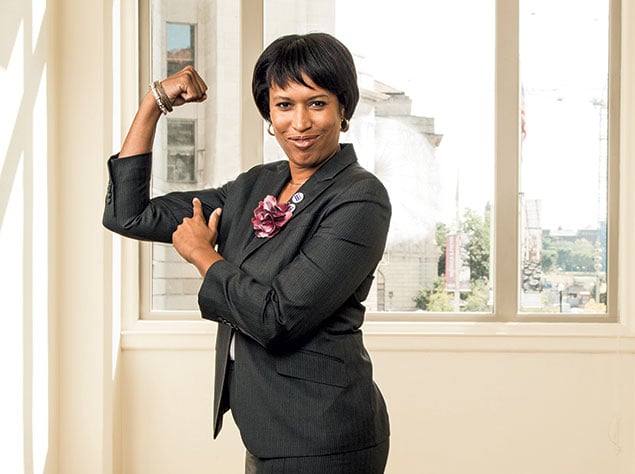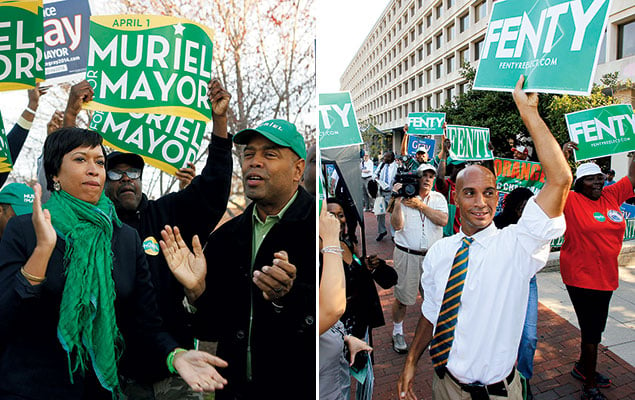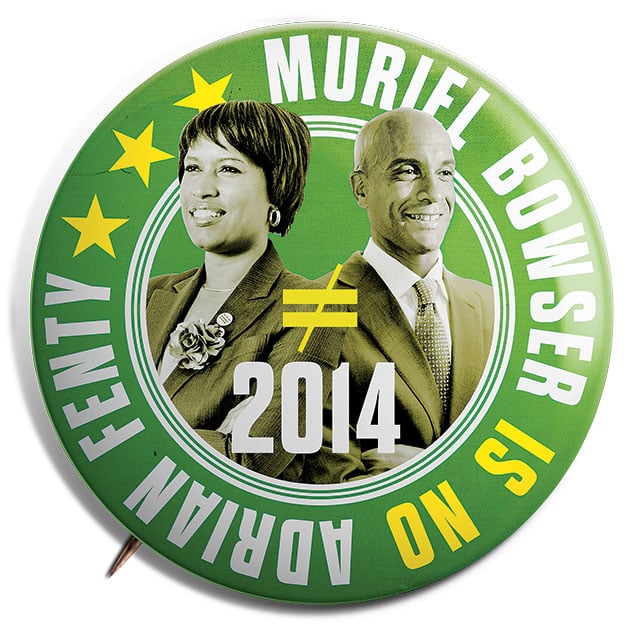When DC’s Democratic voters went to the polls to pick a mayoral nominee in April, the most influential name in the race didn’t belong to Muriel Bowser, the woman who won, or to Vincent Gray, the incumbent she beat. It belonged to someone who wasn’t on the ballot, or even living in the city: Adrian Fenty.
Four years earlier, Fenty had been trounced in the same primary, booted from the mayor’s office after a single, polarizing term. This time it was Gray, the man who beat him, who was beleaguered. And it wouldn’t be a stretch to say that the rival who took Gray down was a woman who owed her entire political career to the former mayor.
Bowser was plucked from obscurity by Fenty, who endorsed her to fill his council seat in 2007. Like Fenty, she was young and energetic, representing one of the capital’s most racially mixed constituencies. Bowser seemed to support the same constellation of progressive causes as her patron—and, in return, the Washington Post blessed her mayoral campaign.
Seven years later, Bowser still relies on Fenty’s network. Her fundraising base is full of folks like developers Chris Donatelli and John Akridge, lobbyist Max Brown, and businessman Ben Soto—the same crew who bankrolled Fenty’s rise. Who’s on her political team? Campaign chair Bill Lightfoot, adviser David Jannarone, and activist Terry Lynch—all of whom helped elevate Fenty from hyperactive DC Council backbencher to domineering mayor.
For that matter, take a look at the electoral map from April: The collection of neighborhoods Bowser captured on the affluent west side of town doesn’t exactly line up with what you might expect from a Northeast DC resident with a thin legislative record. But it does correspond very nicely with a map of Fenty’s most fervent support in his 2010 reelection bid.
Add it all up—Bowser uses the same green signage, too—and it’s tempting to see Bowser’s April win as a restoration. In a primary season marked by low turnout and low enthusiasm, many of her voters seemed to think she was “Fenty in a dress,” as one Democratic activist in her ward put it. It was an impression that helped make her victory possible.
And one that makes a lot of sense, until you actually spend five minutes with the candidate—who may well be the most careful, nonconfrontational DC pol I’ve ever covered.
Ask how she would contend with gentrification that’s raging across the city and she says: “I will grow the middle class.”
Her approach to legislating while on the council for seven years? “I tried to fill holes in the laws.”
Her plan for improving DC’s failing public schools? “Alice Deal for all,” she replies, referring to the much sought-after Tenleytown middle school. When she elaborates, she piles on more platitudes.
Ask the 42-year-old candidate whether she’s prepared to lead the city and manage a government with an $11-billion budget and you get an answer that sounds less than full-throated. “It’s a big jump for anybody,” she says. “You have to be mayor to be mayor.”
By contrast, here’s what her mentor said just before his own election: “If you think of the role of mayor,” Fenty told the Post in 2006, “it’s someone who puts forward bold ideas and sticks to them.”
Whatever Bowser’s voters think they’re getting, it won’t be Fenty 2.0 or a repeat of the ambitious, exasperating mayoral term that ended in 2010. And that might not be a bad thing.
• • •

Here’s what you need to know about DC politics: It has always been about race and class. Here’s what you need to know about DC politics in the 21st century: The winner of a contest that’s still all about race and class is no longer a foregone conclusion.
This year, in a city where Democratic nominees used to win by default, the general election will count. Bowser is facing a smart, savvy Republican turned independent named David Catania, a man with a long record of winning citywide races. Veteran pol Carol Schwartz has also jumped into the race.
Meanwhile, the city is in the midst of radical demographic changes. New residents, mostly young and white, are streaming into town and moving into formerly black neighborhoods. For the first time since the 1960s, African-Americans no longer make up the majority of residents. The electorate hasn’t changed quite as quickly, but it’s hardly the same constituency that elected Marion Barry mayor four times.
The modern, affluent DC represented by these 21st-century newcomers thrilled to Adrian Fenty. As a BlackBerry-wielding councilman, he took high-wattage, contrary positions—against public funding for a baseball stadium supported by most of the establishment; for a smoking ban opposed by the hospitality industry; for devoting $1 billion to rebuild the city’s decrepit public schools—and held press conferences to trumpet them.
“We called him the 12-to-1 member,” says veteran council member Jack Evans, whose district winds from old-money Georgetown through downtown to fast-gentrifying Shaw. “He would always be the one vote against the majority.”
As mayor, Fenty pushed his game into high gear. Demanding efficiency and accountability, he fired people who didn’t measure up. He took over the public schools and never wavered as nationally known reformer Michelle Rhee elbowed aside anyone who opposed her version of reform. He actively disregarded the DC Council. When people griped, Fenty threw around a Margaret Thatcher line: “Consensus is the absence of leadership.”
It’s safe to say this is not a line we’ll hear from Bowser. “I have always kind of approached situations to try to get as much information as I can,” she told the Post last year, explaining how she stays connected with voters, one of Fenty’s major shortcomings. She added: “Oftentimes we meet in the middle.” When the council first considered a controversial bill to raise DC’s minimum wage for big-box stores like Walmart, her reaction was “It is a conversation we need to have.”
That’s a favorite Bowser line—one that oozes inclusiveness while avoiding commitment. And it’s certainly the sort of campaign-season pose you might strike if you’d had a ringside seat to your bullheaded mentor’s collapse.
But a glance at Bowser’s tenure as an elected official shows someone who is Fenty’s opposite in many ways: Where he was forceful and willing to take contrary positions, she has been cautious and has rarely strayed from the safe middle ground. He relished firing low performers; she’s kept a stable office staff. (In August, Bowser did sever ties with adviser Tom Lindenfeld after a Philadelphia newspaper reported that he appeared to have been involved in an alleged illegal campaign-finance scheme there. Prosecutors haven’t charged Lindenfeld.) Fenty was brash and clear; she’s careful and hard to read. Bowser’s colleagues often haven’t been able to figure out where she stands, calling her “enigmatic,” “removed,” “tightly held.”
“I don’t see much similarity,” says Jim Graham, the longtime Ward 1 council member who served with Fenty and Bowser. “Adrian was able to think quickly, decide, and move on. Muriel is much more contemplative and not as spontaneous. She’s extremely careful. That’s the way she’s played her hand. She’s very sharp.”
At what point did Bowser display passion and leadership? Says Graham: “I’ll have to think about that.”
• • •
Bowser has cosponsored many bills but has authored and pushed through few that have had a major impact. She got laws on the books that cut taxes for seniors, gave homeowners the right to mediation before foreclosure, and strengthened tenants’ rights. (The noncontentious vote tallies: 12-1, 12-0, and 13-0.) When council members tried to raise wages at big-box stores like Walmart, she was with them, then she was against them.
Even Bowser’s signature bill—a 2011 ethics-reform measure—became a compromise that mollified her colleagues but dismayed reformers. Washington Post columnist Colbert King called the bill, which passed 12-1, “a toothless wonder” because he said it failed to sever financial ties between lobbyists and elected officials and left in place constituent-service accounts that he saw as slush funds. Matt Rumsey, a policy associate with the Sunlight Foundation, wrote that Bowser’s bill “contains significant loopholes, has relatively weak enforcement and punitive powers, and ignores or passes the buck on some much-needed reforms.”
So might DC be on the brink of electing a conciliator masquerading as commander? It’s more complicated than that. In fact, Bowser has qualities that might make her a better leader than Fenty.
Where Fenty ignored people, Bowser listens. She’s patient with colleagues and constituents. To get her ethics-reform bill through, she had to meet one-on-one with colleagues and hold a series of hearings to lobby 11 of them to back the legislation. Although the law came under attack for leaving loopholes, it did make modest fixes. It didn’t kill constituent-service funds, previously a sacred cow, but did slice them in half, to $40,000 a year. She took the position that something was better than nothing and got it done.
Bowser has tried to fashion herself as a bridge between divergent interests, particularly on issues that divide the city’s newcomers and longtime residents. When the Army turned over the Walter Reed medical center to the District in 2011, residents sparred with developers over how much housing, offices, and open space would fill the 110 acres in Bowser’s ward. Advocating for her constituents, Bowser helped craft a plan that included senior housing, two charter schools, and abundant parkland. She also passed legislation to establish a community advisory panel for the anticipated 20 years of construction.
Fenty let the perks and power of the mayor’s office cloud his judgment. He used cops to escort his midday bike rides through Rock Creek Park, kept the funding of his trips to Dubai and Beijing secret (they were partly paid for by his foreign hosts), and let a buddy chauffeur him around town in city vehicles. Nothing about Bowser’s seemingly frugal lifestyle suggests that power would go to her head as it did her mentor’s. The modest, semidetached home in Riggs Park that she bought for $125,000 in 2000 is almost paid off, she says. She’s always put together but doesn’t appear to be taken with expensive clothes or flashy jewelry. Her black Lexus SUV may be her only extravagance.
“I have never felt entitled to any of my elected positions,” she says. “I’ve never gotten drunk by them. In four years, I could be doing something else.”
• • •

As the front-runner, Bowser has obvious political incentives for being vague about herself. But she had a reputation for being “inscrutable,” in the words of council colleague and mayoral-primary rival Tommy Wells, long before she ran.
Her personal life is a blank slate: She says she dates men, but she reveals nothing about her relationships. A lifelong Catholic, she says her religion hasn’t had that big an impact on her. Her interviews come off as scripted, and she bristles at being challenged, one reason her campaign has worked to limit the number of debates and forums where she’d have to confront Catania.
About the only thing she’s been emphatic about is that she loves her hometown—which, when you’re running for a job at city hall, isn’t exactly daring. That’s not to say she’s wrong in portraying herself as a true-blue daughter of the District, with roots going back five generations. Her mom, Joan, was a nurse; her dad was a facilities manager with DC Public Schools. They scraped money together to send her and four siblings to Catholic schools in the suburbs. “Forty years and only six days’ sick leave,” says Joe Bowser, now 78.
Young Muriel was by her father’s side as he ran for office himself—he was a neighborhood commissioner in the 1970s and mounted an unsuccessful council run—but few friends thought she had the temperament to be a pol herself. “I could see her running someone’s campaign, in a strategic way, behind the scenes,” says Tamara Watkins, Bowser’s close friend. “It was difficult seeing her at the forefront.”
After graduating from Chatham University in Pittsburgh, Bowser lived in Philadelphia working as an insurance-claims adjuster and then in Silver Spring, doing constituent and policy work for Montgomery County. I ask her one morning whether she envisioned herself jumping into politics. “No,” she says. “I saw myself in government, perhaps running an agency.”
She claims she had no intention of running for mayor until early last year, when she saw that Mayor Gray was weakened by allegations of corruption. In a rare case of Bowser staking out a bold position, she became one of three council members to call for his resignation. Her animus for the mayor, in fact, is one place where the human Bowser peeks from behind the campaign curtain: She says she believes Gray was part of a “cabal” out to bring down her friend Fenty.
Yet beneath the surface (and their age), Bowser and Gray have much in common: Both come from solid families in the District’s working class and have deep roots in the political culture. Gray ran Mayor Sharon Pratt Kelly’s human-services department and was elected to the council three years before Bowser. She learned politics from her father, who’s been active in DC affairs since 1975. Like Gray, who’s known as a micromanager, Bowser likes to delve into the details. She’s measured and deliberative, sometimes guarded, qualities she shares with Gray. Both have a tendency to be testy and defensive.
And therein lies the irony: The people who were most excited about getting rid of Gray wound up voting for someone who might well be a rerun. Bowser says that his top cop, Cathy Lanier, is “the best police chief in the United States” and that she plans to keep her on the payroll. Her plans for DC schools: “Not stopping progress under the leadership of Kaya Henderson,” Gray’s school chancellor.
Ambitious? Of course. Historic? Doubtful. If she prevails, good enough to shepherd a city through major demographic change without getting booted by longtime residents or investigated by the feds? Just maybe.
National editor Harry Jaffe can be reached at hjaffe@washingtonian.com. This article appears in the October 2014 issue of Washingtonian.


















